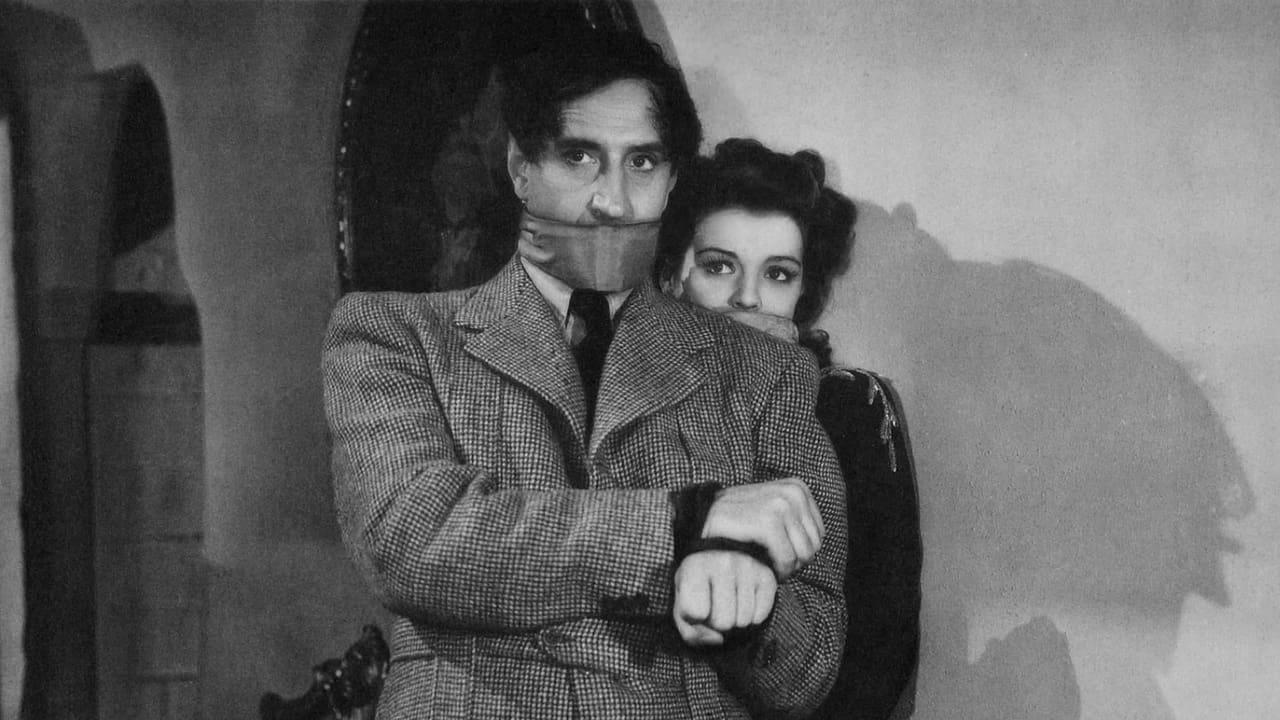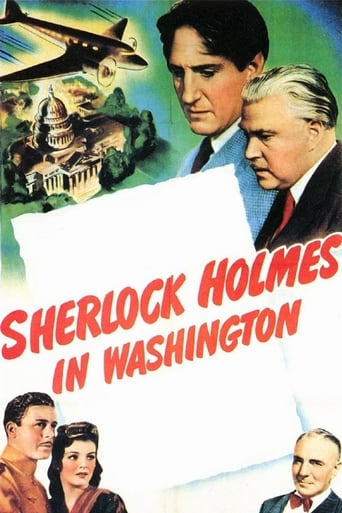utgard14
Third in the Universal series of Sherlock Holmes films is another strong one with a WWII plot. A British secret agent carrying important documents is kidnapped en route to Washington, D.C. The British government turns to Sherlock Holmes (Basil Rathbone) to find the agent and the documents. Together with Dr. Watson (Nigel Bruce), Holmes journeys to America to investigate.Rathbone and Bruce are terrific, as usual. This is the last entry in the series where Rathbone sports that silly hairstyle. George Zucco and Henry Daniell are great villains, which should surprise no one. They both played Holmes' nemesis Prof. Moriarty in other films. Holmes Herbert, Thurston Hall, Gavin Muir, and Edmund Macdonald are among the fine actors in the wonderful supporting cast. Marjorie Lord provides the pretty. Strong direction from Roy William Neill.It's a very entertaining movie. No backhanded compliments here. No "best of the propaganda Holmes films" or "thankfully not as much flag-waving as the previous two films" or any of that stuff. Unlike some other reviewers I don't respond to patriotism (especially during WWII) like the Wicked Witch responds to water. After this entry, Holmes would return to murder mysteries although still taking place in the (then) present day rather than the Victorian era, much to the consternation of Holmes purists. I have my thoughts on that but I'll just quote John Archer, the actor who played Lt. Pete Merriam in this film: "Those Sherlock Holmes fans -- by God, they are rabid. They want everything to be just the way it was."
lugonian
SHERLOCK HOLMES IN WASHINGTON (Universal, 1943), directed by Roy William Neil, marks the fifth entry of the popular series and third installment in the newly updated format starring Basil Rathbone (Sherlock Holmes) and Nigel Bruce (Doctor Watson). Once again there's assurance for its movie going audience this is the Holmes and Watson of modern times by lifting the original titled opening from SHERLOCK HOLMES AND THE VOICE OF TERROR (1942) to read, "Sherlock Holmes, the immortal character of fiction created by Sir Arthur Conan Doyle is ageless, invincible and unchanging. In solving significant problems of the present day, he remains - as ever - the supreme master of deductive reasoning." Since Tarzan can go to New York (TARZAN'S NEW YORK ADVENTURE (MGM, 1942)) and/or every other movie sleuth venture around the world solving individual murder cases, why not Sherlock Holmes leaving his natural surroundings of England? This is what Holmes and Watson get to do for their next assignment, coming to America and visiting our nation's capital, Washington, D.C. Though Holmes doesn't get to have tea with the president in the White House lawn, he does, however, have opportunities getting a glimpse of many of its landmarks while doing what he does best, deductive reasoning.The 12 minute prologue opens at the London Terminal Transatlantic Airport where an assortment of passengers come on board an airplane bound for New York City, one of them being Sir Henry Marchmont (Gilbert Emery), a British diplomat who, unknowingly, is being carefully observed by William Easter (Henry Daniell). Arriving at the last moment before the plane's departure is the seemingly drunken, accident prone John Grayson (Gerald Hamer) who seats himself across from Easter. While on the Washington Express bound for Washington, D.C., Grayson, senses great danger as he notices Easter and his spies, Cady (Bradley Page) and Howe (Don Terry), keeping close eye contact on him. While conversing with other passengers, Grayson permits himself by lighting a cigarette for Nancy Patridge (Marjorie Lord) before placing a match folder with well concealed microfilmed documents inside her purse. Moments after a sudden blackout, Grayson is abducted. Because Grayson has never reached his destination, Mr. Ahrens (Holmes Herbert) of the British Empire, assigns Sherlock Holmes (Basil Rathbone) and his associate, Doctor Watson (Nigel Bruce) to Washington, D.C. Aside from being in constant danger themselves, Holmes and Watson attempt to solve Grayson's disappearance, some murders, and locate the now missing Nancy Partridge, believed to be connected with Grayson's missing document by Richard Stanley (George Zucco), a local antique shop owner.For the first time in the series, the story reportedly doesn't use any of Sir Arthur Conan Doyle's "Sherlock Holmes" stories as its sources, but borrows in areas from its previous installment, SHERLOCK HOLMES AND THE SECRET WEAPON (1942). Though the opening titles credit Bertram Milhauser for its original story, the screen treatment repeats the idea of subject matter, this time a London lawyer turned secret agent, falling victim of enemy spies, and Holmes called to locate a secret document before reaching enemy hands. While Holmes in SECRET WEAPON finds its ringleader to be his arch rival, Professor Moriarty (Lionel Atwill), he matches wits here with the an earlier Moriarty, portrayed by George Zucco (THE ADVENTURES OF SHERLOCK HOLMES (20th-Fox, 1939)) and future Moriarty, Henry Daniell (THE WOMAN IN GREEN, 1945). Such a missed opportunity by not having Zucco reprise his most memorable role, considering how his new character, using the frequent saying of "Permit me!" to contain enough ingredients of the sinister Moriarty. For classic moments, be on the lookout for Rathbone's most amusing guise of an eccentric art collector and Zucco's method of introducing the captured Holmes to his hostage Nancy: "Allow me to present Mr. Sherlock Holmes, the world's famous detective. He's here to rescue you."SHERLOCK HOLMES IN WASHINGTON, the most Americanized of the Rathbone-Bruce installments, contains familiar American types including Thurston Hall (Senator Henry Babcock); Edmund MacDonald (Detective Grogan); Clarence Muse (George, the train waiter); and John Archer, Nancy's fiancé, Peter Merriam, lieutenant in the United States Navy. There's also some fine insight centering upon Doctor Watson's interest in America customs as drinking milk shakes, chewing gum and reading the comics and sports pages from newspapers. Though Sherlock Holmes smokes a cigarette or two, which he's done before in prior modern day London installments, he does get to recite a then current speech by Sir Winston Churchill. Overall, how that match cover passes in and out of enemy agents' hands without them knowing about it, should rank this another winning entry. And yes, Mary Gordon returns briefly as Holmes' landlady, Mrs. Hudson, for one brief scene.Distributed to video cassette by Key Video (1988) and two decades later onto DVD, SHERLOCK HOLMES IN WASHINGTON, along with other Rathbone/ Bruce installments, premiered December 26, 2009, on Turner Classic Movies as part of the cable channel's tribute to the legendary detective. Permit me in concluding the next installment being SHERLOCK HOLMES FACES DEATH (1943) by adding to the pun, "When didn't he?" (**1/2)
TheLittleSongbird
Not one of the best of the series like Hound of the Baskervilles, Adventures of Sherlock Holmes and Scarlet Claw, but of the wartime-based Sherlock Holmes films Sherlock Holmes in Washington comes across as the best one. That is not to say the others were bad, Secret Weapon was fun and Voice of Terror had some good things too, though generally it was lacking and the, or one of the, weakest of the series. Sherlock Holmes in Washington can feel padded, particularly in the middle, the ending could have done with more punch and some of the propaganda is rather in-your-face(not as badly as Voice of Terror though). However, it is smoothly directed and photographed with evocatively rendered sets. The music is jaunty and atmospheric, the dialogue is generally thoughtful and the story has a good amount of mystery, suspense and fun. It is also very intriguing, and scenes like at the dinner party and Holmes in the antique shop are very well done. Basil Rathbone, apart from a very distracting hair-do, is wonderful as Holmes(regarding Holmes in movies he was without peer though second only to Jeremy Brett in general). Nigel Bruce is amusing as Watson, he can be too much of a blustering, bumbling fool in the series but it's not so bad here. George Zucco brings the right amount of menace for his villainous role despite him having too few scenes, while Henry Daniell is similarly creepy. The secondary roles of some talented character actors add to the fun too. Overall, a good entry, while not one of the best of the films starring Rathbone- the series works so much better in the Victorian era with the odd horror element amongst the suspense and mystery- it was the best of the ones based in the wartime. 7/10 Bethany Cox

